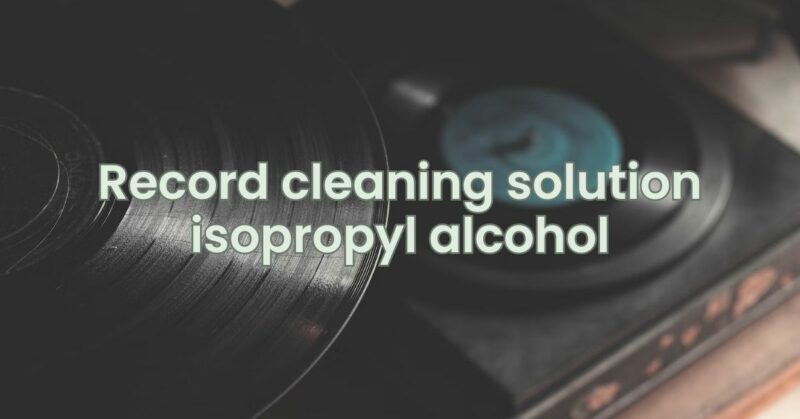Vinyl records have a timeless appeal, offering a nostalgic and authentic listening experience for music enthusiasts worldwide. To maintain the optimal sound quality and preserve the longevity of these cherished records, regular cleaning is essential. One common ingredient found in many record cleaning solutions is isopropyl alcohol. In this article, we’ll explore the role of isopropyl alcohol in vinyl record care, its effectiveness, and best practices for using it to clean your vinyl collection.
Understanding Isopropyl Alcohol:
Isopropyl alcohol, also known as rubbing alcohol, is a clear, colorless liquid with a strong odor. It is a common solvent and disinfectant used for various purposes, including cleaning electronics, medical equipment, and optical devices. In the context of vinyl record care, isopropyl alcohol is sometimes used as an active ingredient in cleaning solutions to remove stubborn dirt, fingerprints, oils, and contaminants from the record’s surface.
The Role of Isopropyl Alcohol in Record Cleaning Solutions:
Isopropyl alcohol is known for its ability to dissolve and remove various substances effectively. In record cleaning solutions, isopropyl alcohol serves several purposes:
- Cleaning Power: Isopropyl alcohol acts as a powerful cleaning agent, breaking down and removing dirt and contaminants from the vinyl record’s surface.
- Quick Drying: Isopropyl alcohol evaporates quickly, which helps ensure the record dries faster after cleaning, minimizing the risk of water damage.
- Disinfectant Properties: Isopropyl alcohol has disinfectant properties, which can help remove bacteria and germs from the record’s surface.
Best Practices for Using Isopropyl Alcohol in Record Cleaning:
If you decide to use a record cleaning solution that contains isopropyl alcohol, follow these best practices to ensure safe and effective cleaning:
- Use Diluted Solutions: Avoid using undiluted isopropyl alcohol directly on vinyl records, as it can be too harsh and may cause damage. Instead, opt for a diluted solution with a lower alcohol content.
- Choose High-Quality Products: Look for record cleaning solutions specifically designed for vinyl records that contain a balanced blend of isopropyl alcohol and other gentle cleaning agents. Avoid using solutions with high alcohol content, as they may be too abrasive.
- Gentle Application: Apply the cleaning solution sparingly to a soft, lint-free microfiber cloth or a record cleaning brush. Gently clean the record’s surface in a circular motion, following the grooves. Avoid excessive pressure to prevent damage to the vinyl.
- Avoid Direct Contact with Labels: When cleaning near the record’s label, take extra care to avoid direct contact with the label to prevent potential damage or discoloration.
- Rinse with Distilled Water (Optional): If the record cleaning solution contains a higher concentration of isopropyl alcohol, consider rinsing the record with distilled water after cleaning to remove any residue.
- Thorough Drying: After cleaning and, if necessary, rinsing, ensure the record is thoroughly dried with a clean, dry microfiber cloth before playback or storage.
Conclusion:
Isopropyl alcohol plays a significant role in many record cleaning solutions, offering effective cleaning power and quick evaporation. When used properly and in the right dilution, isopropyl alcohol can safely help remove dirt and contaminants from vinyl records. However, it’s essential to exercise caution, follow best practices, and avoid using undiluted isopropyl alcohol directly on vinyl records, as it can potentially damage the vinyl surface. By using high-quality record cleaning solutions containing isopropyl alcohol, combined with proper storage and handling practices, you can keep your vinyl records in excellent condition, preserving their authentic sound quality and enhancing your listening pleasure for years to come.


